
 |

|
| |
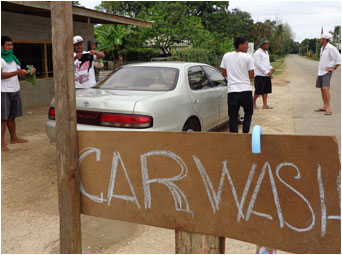
|
|
 |
Day 2,341 - Tongatapu (21° 08S 175° 11W)
09:01hrs - October 28th 2013
Next Stop... New Zealand! |

Sailing from Ha'apai to Tongatapu, our last stop in Tonga, finally produced the long awaited evidence that you can indeed catch fish while having bananas onboard! We have been waiting a very long time to disprove the ‘bananas equals zero fish’ theory, put to us by the way by a seasoned American fisherman, and it was taking so long I was secretly beginning to believe he might be right. But bananas and fish did finally happen and we took a photo to prove it, at long last! So perhaps it maybe just takes a really really long time to catch fish if you have bananas onboard? Who knows, trouble is, we quite like bananas, and we like fish too. Conundrum!
We only had a brief time in Tongatapu but we tried to cover as many miles as we could in our rental car exploring all the ‘must sees’ but the most fun turned out to be getting pulled over by what initially appeared to be an angry mob on the sides of the road, but what turned out to be a wildly enthusiastic cricket team raising money for the next days game by persuading passing motorists to stop for a cricket team car wash! The flying fox bats, the swimming cave, the Stonehengesque structure and the fire dancing were great too, but the happy Tongan cricketers won the fun prize.
We are now down to our last few days in the toasty part of the South Pacific, at the southern end of the Tonga island group, getting ready to set off for New Zealand. All the other boats anchored around us are making the same passage preparations, having the same weather discussions and commiserating about the end of the Pacific sailing season, but there is an excitement in the air and you can sense the revving of mental and emotional engines as a potentially cold, wet and windy passage looms. This will be our third trip down to NZ and although the route may be the same, that will probably be the only thing that is. Weather plus open ocean combinations are infinite, so we are preparing for everything. We will be carrying bananas so we may not catch any fish this time, but we'll keep you posted.
|
|

| |
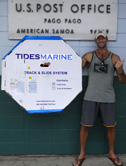

Welcome aboard
Tides Marine!
Click here to learn why we wouldn't want to raise our sail without them >
|
| |
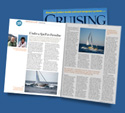
Hot Off The Press!
Click here to read our
article in the November
issue of Cruising World magazine >
|
|

| |
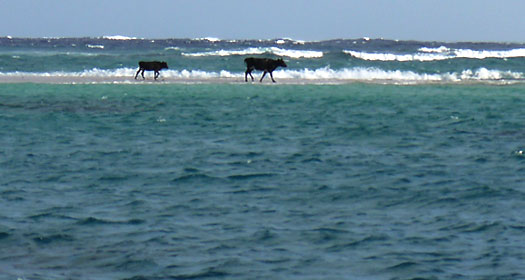
|
Quick Fix: 19° 57.9 S / 174° 29.5 W
October 20th 2013 (day 2,333)
Conditions: Wind: 20-25/ESE Sky: Mostly Clear

No Bull
If someone had told me that whilst anchored in the remote region of central Tonga, it's possible that we might just see cows strolling between tiny, uninhabited sandy islands, well, I would have said that would be about as likely as spotting a coconut crab crawling around the Long Island Sound. But today, anchored between the islands of Uonukuhihifo and Uonukuhahake in the Ha'apai archipelago, cows strolling between islands was precisely what we saw. Catherine and I watched in disbelief from the boat when two cows stepped out from tropical brush onto the beach, and with open South Pacific surf crashing just behind them, casually wandered across a sandbar that was very nearly awash. I know this sounds like a bunch of bull, but it's a true story - really. - NH
|
|
|

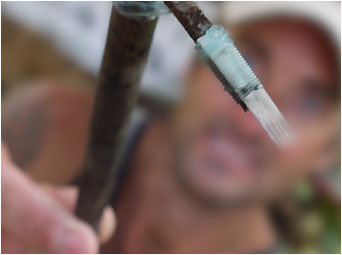
|
|
 |
Day 2,321 - Hdg to Tonga (18° 16S 173° 48W)
11:37hrs - October 8th 2013
Now, Hold Still, This May Hurt Just a Little... |

We've left the Samoan islands behind and are now en route to Tonga, but before we left I got a little Samoan Souvenir - a traditional tattoo, or tatau, traditional not only by its design, but also in its application.
Unlike many other Polynesian islands that are a-buzz with the noise of tattoo machines efficiently inking locals and tourists alike, Samoa still clings to, or rather, taps to, its old customs, which have essentially remained unchanged for thousands of years.
Tattoo Masters must serve as apprentices for six years before they earn the title of Tufuga ta Tatau. First they must understand the significance and origins of each design and motif, then learn to fashion their own instruments from boars tusks, before proceeding to the delicate procedure of skin pulling and of course, the most important of all, tapping. Only once they have mastered all these skills, especially the tapping part, are they allowed to begin hammering away on their subjects with any degree of impunity.
My Tufuga ta Tatau's name was Williesone, or Wilson, who is known throughout the Samoan islands as one of the best in his trade, and he was accompanied by his trusty apprentice Leai, who is still at the skin-pulling stage of his degree. We met at Tisa's Barefoot Bar, an idyllically rustic Robinson Crusoe-style restaurant, with sleeping fales, that seems to be constructed mostly from driftwood and wreckage, which rests perfectly on the sandy shores of Alega Beach on Tutuila's southern shoreline.
After explaining to Wilson that all I wanted was a simple wrist band to frame a compass rose I had tattooed in the Marquesas, rather than a traditional Samoan pe'a - a complex design that wraps completely around the male body from upper waist to the knees (a procedure that can take up to a week to complete) he thankfully selected his smaller more delicate instruments, where the rows of needles were a forgiving half inch wide rather than a shocking four inches, and professionally went about this work.
Surprisingly the process was not as painful as you would imagine. After-all, the very idea of someone tapping sharpened boars tusks into your skin, deep enough to make a permanent impression, well, let's just say I was braced for the worst, and so I laid down on woven palm mats, hiding under my baseball cap to mask any betrayal of distress or tears of pain I thought would freely flow throughout the procedure. But I'm proud to report that, except for the areas where he was literally tapping into bone (in retrospect perhaps the wrist wasn't the most forgiving area for a tatau) I managed to endure the operation without disgracing myself.
Wilson began each new mark by 'air tapping', and only when he was certain of the alignment would he slowly lower the tusk, tapping as he went, until he broke skin, before continuing with progressively harder taps, driving the points deeper until he was satisfied. Compared to the tattoo machine, which, for me at least, felt like an unpleasant and continuous electric shock, this traditional method seemed to numb the area, so thankfully by the time Wilson reached the desired depth, it registered more as a dull pounding, rather than a sharp pain.
At any rate, it was still an uncomfortable experience, so for the thirty minutes Leai stretched my skin and Wilson carefully tapped away into it, I tried to focus only on the soothing sounds of the South Pacific. I also thought about how far we've traveled on Dream Time, how completely different our lives are compared to our time in New York, the unique experiences we've had, all those yet to come, the impressions they have all made, and what a grand adventure we are now living.

Always wanted a traditional tattoo? Visit Tisa's Barefoot Bar in American Samoa (tel: 1-684-622-7447). 'Candyman' will contact Wilson for you and help arrange the details. He can also rustle up a delicious plate of grilled fish, prawns, taro and baked bananas too! |
|

|

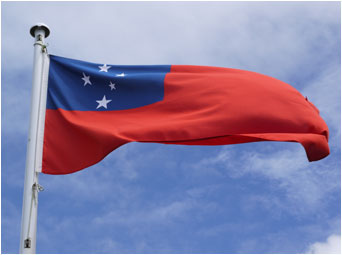
|
|
 |
Day 2,318 - Apia, Samoa (13° 49.7S 171° 46.3W)
08:13hrs - October 5th 2013
15 Hours in 25 Minutes |

Just because we're sailing around the world, who says we can't choose to fly every now and again? We've just returned from the independent nation of Samoa (formally Western Samoa) which, from anchorage to anchorage, lays seventy-five away from Pago Pago, about fifteen hours of sailing - an overnight passage. But by plane it takes just twenty-five minutes and can be transited over a cup of coffee, and as we were still waiting for the last of our packages to arrive into American Samoa from the States, we decided to leave Dream Time anchored in Pago Pago and spend four of those days waiting in Samoa.
Unlike American Samoa where tourism is practically nonexistent, it is the main industry in Samoa, and from the moment you arrive in the capital of Apia, visitors will not be disappointed. There's a flea market with a labyrinth of stalls selling all kinds of Samoan souvenirs, from colorful lavalavas (sarongs), t-shirts, wood carvings, bowls, traditional woven mats and tapa cloths. There's a savoury selection of restaurants, and coffee shops, and a variety of hotels around the island, from simple backpacker beach fales (a traditional Samoan house/gathering area, consisting of nothing more than a thatch roof suspended over a wooden floor), to perfectly groomed five-star resorts.
We toured the island by car, visiting tiny villages hidden away in coves along the southern shoreline, we swam in sinkholes and strolled sandy shores, and spent an entire morning just soaking up the colorful atmosphere at Apia's main bus station. We spoke to friendly traffic police, bought popcorn for two tala ($1) from street vendors, and watched local Monday morning commuters casually shuffling about their business in dusty sandals at a pace that was distinctly Samoan.
We flew back to American Samoa later that day, crossing the international dateline and leaving daylight savings behind, arriving in Pago Pago the day before we left, and an hour behind. Dream Time was right where we had left her and our package from the States, the last one we've been waiting for, had finally arrived! |

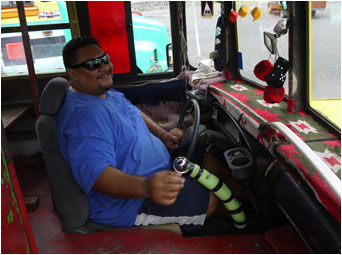
|
|
 |
Day 2,314 - Pago Pago, American Samoa (14° 16.3S 170° 41.8W)
09:33hrs - October 1st 2013
American Samoa - Having A Nice Stay! |

There's something quite special about American Samoa, and if you can bare to stay here just long enough to get past first impressions, you may find it surprisingly intoxicating, and like some cruisers who were seduced by its distinctive charm, you may very well decide to stay for years.
If you arrive by sea expecting an idyllic tropical anchorage you haven't done your homework, and subsequently you will be hugely disappointed, a sublime anchorage this is not. The capital city and commercial harbor of Pago Pago (pronounced pa-ngo pa-ngo) on the island of Tutuila, not only boasts the highest annual rainfall of any harbor in the world, a staggering twenty-feet, but it is also home to Starkist, an industrial tuna cannery that operates around the clock and regularly belches out a pungent odor that smells distinctly of rotten cabbages. The fresh tradewinds that funnel from open ocean into the harbor quickly become contaminated with this stench, and carry it downwind, all the way to the yacht anchorage, which lays at the very dregs of the harbor.
When it rains, which is most days (and nights), run-off from the towering cliffs that surround Pago Pago, which lies in the remains of a collapsed volcanic crater so large it almost split the island in two, quickly drains sediment, countless McDonald's cups and plastic soda bottles into the harbor, turning it into a giant, litter strewn, muddy kava bowl. We've been here two weeks and not once dared to run our watermaker. And in an effort to assault all your senses, the relentless drone of a generator plant, which, ideally located on the very edge of the harbor next to the Starkist cannery, mingles with the stench of rotten cabbages and is wafted directly to your boat. It is a noise that when it enters your consciousness, becomes almost impossible to ignore. No, Pago Pago is most definitely not a tranquil anchorage. But even with all these rather unfortunate distractions, we have come to love it here.
American Samoa is the only inhabited American territory in the southern hemisphere, yet there is virtually no tourism here, so the lucky few who visit, and have more than just a few days to spare, are in for a unique experience and an unlikely combination, one that is both authentically Samoan and familiarly American.
The island has a sweaty, gritty tropical appeal, one that's dripping with character and is best seen by local bus. Many seem oddly out of scale and proportion, especially when you consider the size of the average Samoan riding on them. Drivers, too, barely seem to fit and are wedged into holes cut out of plywood floors that would make a quick exit virtually impossible. With colorful paint jobs, custom graphics and pimped-out interiors adorned with dangling trinkets, tassels, fake fur or feathers, dozens of tiny mirrors, air fresheners and dashboard shrines dedicated to everyone from Bob Marley to Jesus Christ, well, it's amazing the driver can even see out the window.
Each bus carries a name, like 'Happy Valley', 'Titanic Hero', 'Tears of Victory' and 'Sunset Express', and they trundle around the island for the bargain price of just $1- $2 a ride, blasting rap, Polynesian, country or classic rock music so loud it literally makes the plexiglass windows vibrate. When you board you're greeted with 'talofa' (Samoan for 'hello') by big, round, strong, smiling Samoan faces that seem genuinely happy to see you, and as you rattle along the coastal road, with the glittering South Pacific ocean on one side and the steaming tropical rain forest on the other, you find yourself smiling too, for no particular reason, other than you feel just happy to be here.
We've toured the entire island, exploring deserted surf beaten coastlines that could be from the land of lost, where rugged black basalt spires capped with lush vegetation, rise impressively from turquoise lagoons which lap undisturbed sandy shores. We've watched giant flying foxes (fruit bats) glide majestically on thermals over the northern cliffs like frigate birds, and we've driven over the island's bony ridge to quiet bays and secluded Samoan villages on the northern shore.
But what also makes Tutuila so memorable is that it's a paradoxical paradise, where Samoans share a remote island and a very proud traditional culture with a shiny American administration. One that seems out of place here, slightly resented, yet tolerated for its convenience, and that, for the most part, it is run by Samoans.
There's no denying that parts of American Samoa are unapologetically American. The drive-through McDonald's, which when first opened had the distinction of being its most profitable franchise in the world. There's a 'Cost U Less', a warehouse-size convenience store packed to the girders with industrial-size sacks of Coco Puffs, Cheese Balls, tubs of peanut butter, skids of soda and Coors Light beer. The Pago Pago post office conveniently and efficiently ships and receives mail and packages to the States for impossibly low rates. Petrol and diesel are cheap, so most cars and even the Humvees touring the island, operate for only a few dollars a week. Ironically health and dental care in American Samoa are excellent and inexpensive too - a visit to the dentist for cavity work will cost you just $20, and a full cleaning (which has to be booked a month in advance) is only $30. The currency is the US dollar, of course, and a mere $5 phone card can have you talking to friends and family back home for almost an hour.
Paths that wind over the mountain ridges and through dense tropical jungles, that would be nothing more than narrow goat trails on other South Pacific islands, are groomed and regularly maintained by enthusiastic National Park rangers, who, even here, still wear the logo of a indian spearhead containing a bison roaming snow-capped Rocky Mountain plains. Friendly coastguard, police and boarder patrol officials, yes, I said friendly, keep the streets and coastline safe, and at least once a day the familiar and nostalgic wailing of American emergency sirens echo around Pago Pago, making it sound, if only for a moment, like we are back home in New York.
But when the sirens fade, replaced with the familiar droning of diesel generator, which, in the early evening competes with the whistles and chirps from thousands of excited nesting tropical birds returning to banyan trees after a day at sea, and fruit bats circle your mast in fading light, a warm waft of rotten cabbages drifts over your boat, reminding you exactly where you are, and it is unmistakably American Samoa, and there is nowhere else quite like it. |

|
|








![]()